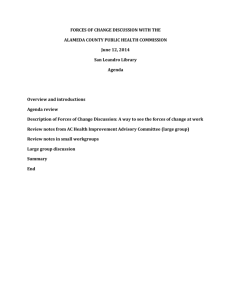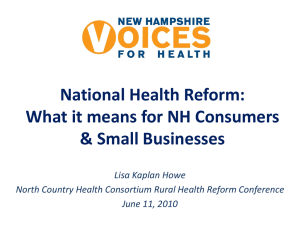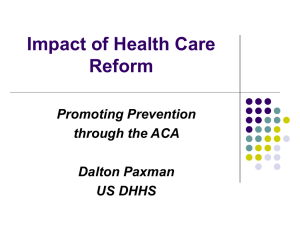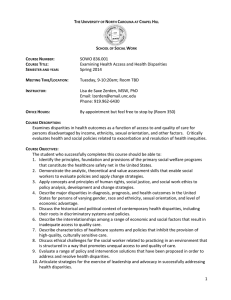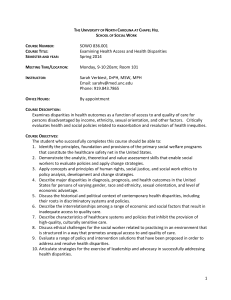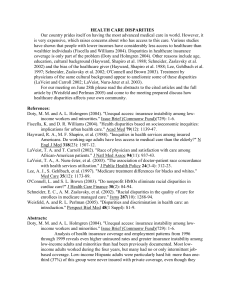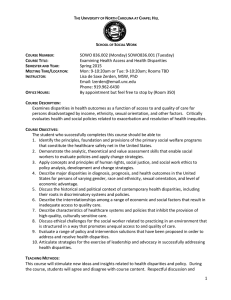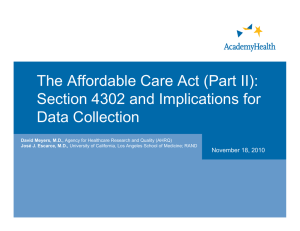here
advertisement
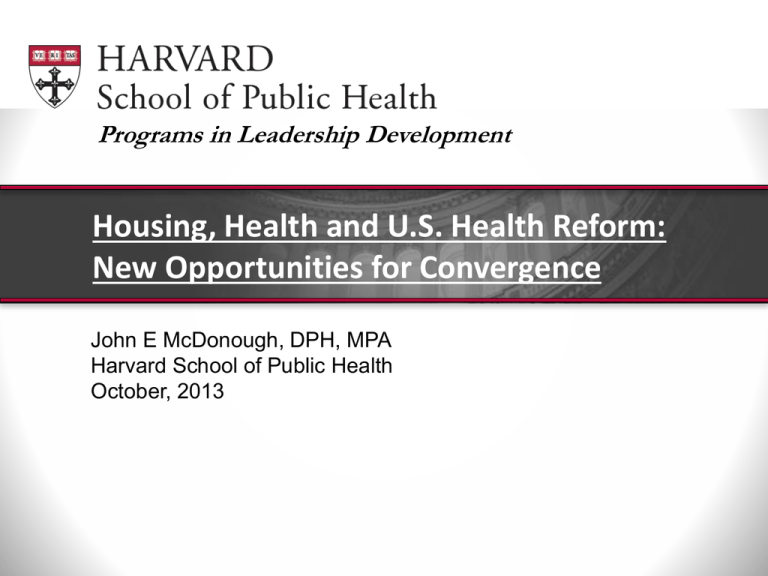
Programs in Leadership Development Housing, Health and U.S. Health Reform: New Opportunities for Convergence John E McDonough, DPH, MPA Harvard School of Public Health October, 2013 Presentation Outline • Why US health reform? • What does the Affordable Care Act do? – Generally and connections to housing • New Opportunities to Align Housing and Health – Coverage and Access – Delivery System Reform and Global Payments – Public Health/Prevention/Wellness Health Spending Per Capita, 2009 Adjusted for Differences in Cost of Living Health Spending as Share of GDP Overall Health System Performance Ranking Country Rankings 1.00–2.33 2.34–4.66 4.67–7.00 AUS CAN GER NETH NZ UK US OVERALL RANKING (2010) 3 6 4 1 5 2 7 Quality Care 4 7 5 2 1 3 6 Effective Care 2 7 6 3 5 1 4 Safe Care 6 5 3 1 4 2 7 Coordinated Care 4 5 7 2 1 3 6 Patient-Centered Care 2 5 3 6 1 7 4 6.5 5 3 1 4 2 6.5 Cost-Related Problem 6 3.5 3.5 2 5 1 7 Timeliness of Care 6 7 2 1 3 4 5 Efficiency 2 6 5 3 4 1 7 Equity 4 5 3 1 6 2 7 Long, Healthy, Productive Lives 1 2 3 4 5 6 7 $3,357 $3,895 $3,588 $3,837* $2,454 $2,992 $7,290 Access Health Expenditures/Capita, 2007 Note: * Estimate. Expenditures shown in $US PPP (purchasing power parity). Source: Calculated by The Commonwealth Fund based on 2007 International Health Policy Survey; 2008 International Health Policy Survey of Sicker Adults; 2009 International Health Policy Survey of Primary Care Physicians; Commonwealth Fund Commission on a High Performance Health System National Scorecard; and Organization for Economic Cooperation and Development, OECD Health Data, 2009 (Paris: OECD, Nov. 2009). The Affordable Care Act and Opportunities to Connect Housing and Health 1. The ACA’s essential components 2. New opportunities to align with housing Housing and Health Connections • Common substandard housing effects: – 1 - allergies; 2 - asthma; 3 - lead poisoning; 4 - injuries • 2 million hospital ED visits for asthma yearly • 2900 people die in house fires yearly • 6 million households live with moderate or severe physical housing problems. • Radon is 2nd leading cause of lung cancer death in the U.S. • Children affected more than adults: – Lead affects children’s growing brains; Older houses with lead paint are the primary cause of lead poisoning affecting about 240,000 children in the US • Spillover effects: – Mental Health effects – increased depression – Economic effects – missed workdays – Education effects – missed school days and poor performance Ten Titles: the ACA’s Architecture I. II. III. IV. V. VI. Affordable and Available Coverage– private insurance Medicaid and CHIP – lower income public coverage Delivery System Reform and Medicare Prevention, Wellness, and Public Health Workforce Initiatives Fraud, Abuse, Transparency, Comparative Effectiveness Research, and more VII. Pathway for Biological Similars VIII. CLASS – Community Living Assistance Services & Supports IX. Revenue Measures X. Manager’s Amendments Key Opportunities for Healthy Housing • Coverage: Many more low-income Americans with health insurance via managed care/global payment • Delivery System Reform: Move away from fee-forservice and toward global payment – Accountable Care Organizations; patient-centered medical homes; readmission penalties; value based insurance design; comparative effectiveness research; CMS Innovation Center • Hospital community benefit standards • Prevention and Wellness: – Prevention Trust Fund ($10B) & community transformation grants – National Prevention Strategy (health in all policies) National Prevention Strategy-1 • National Prevention Strategy/Council: Strategic Directions • Healthy and Safe Community Environments: Create and sustain, communities that promote health/wellness through prevention. – Improve quality of air, land, and water. – Design/promote affordable, accessible, safe, healthy housing. – Maintain a skilled, cross-trained, diverse prevention workforce. • Clinical and Community Preventive Services: Ensure that health care and community prevention efforts are available, integrated, and mutually reinforcing. – Support community-based preventive services and enhance linkages with clinical care. – Reduce barriers to clinical/community preventive services among at-risk populations. – Coordinate/integrate clinical, behavioral, and complementary health strategies. National Prevention Strategy-2 • Empowered People: Support people in making healthy choices. – Provide people with tools/information to make healthy choices. – Promote positive social interactions and support healthy decision making. – Empower people/communities to plan/implement prevention policies and programs. – Improve education and employment opportunities. • Elimination of Health Disparities: Eliminate disparities, improve quality of life for all Americans. – Ensure a strategic focus on communities at greatest risk. – Reduce disparities in access to quality health care. – Increase the capacity of the prevention workforce to identify and address disparities. – Support research to identify strategies to eliminate disparities. – Standardize and collect data to identify and address disparities. Suggestions for You • Familiarize yourselves with aspects of health reform that advance better housing and communities • Start conversations with: – Health insurance companies – Hospital systems – State government and localities with forward thinking leadership – The public health community • Start a new roundtable on housing and health (or health and housing) • Recognize that we’re in a new era with new opportunities


